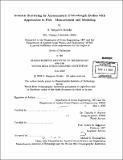Acoustic scattering by axisymmertic finite-length bodies with application to fish : measurement and modeling
Author(s)
Reeder, D. Benjamin (Davis Benjamin), 1966-
DownloadFull printable version (7.049Mb)
Other Contributors
Woods Hole Oceanographic Institution.
Advisor
Timothy K. Stanton.
Terms of use
Metadata
Show full item recordAbstract
This thesis investigates the complexities of acoustic scattering by finite bodies in general and by fish in particular through the development of an advanced acoustic scattering model and detailed laboratory acoustic measurements. A general acoustic scattering model is developed that is accurate and numerically efficient for a wide range of frequencies, angles of orientation, irregular axisymmetric shapes and boundary conditions. The model presented is an extension of a two-dimensional conformal mapping approach to scattering by irregular, finite-length bodies of revolution. An extensive series of broadband acoustic backscattering measurements has been conducted involving alewife fish (Alosa pseudoharengus), which are morphologically similar to the Atlantic herring (Clupea harengus). A greater-than-octave bandwidth (40-95 kHz), shaped, linearly swept, frequency modulated signal was used to insonify live, adult alewife that were tethered while being rotated in 1-degree increments over all angles of orientation in two planes of rotation (lateral and dorsal/ventral). Spectral analysis correlates frequency dependencies to morphology and orientation. Pulse compression processing temporally resolves multiple returns from each individual which show good correlation with size and orientation, and demonstrate that there exists more than one significant scattering feature in the animal. (cont.) Imaging technologies used to exactly measure the morphology of the scattering features of fish include very high-resolution Phase Contrast X-rays (PCX) and Computerized Tomography (CT) scans, which are used for morphological evaluation and incorporation into the scattering model. Studies such as this one, which combine scattering models with high-resolution morphological information and high-quality laboratory data, are crucial to the quantitative use of acoustics in the ocean.
Description
Thesis (Ph. D.)--Joint Program in Applied Ocean Physics and Engineering (Massachusetts Institute of Technology, Dept. of Ocean Engineering and the Woods Hole Oceanographic Institution), 2002. Includes bibliographical references (leaves 140-148).
Date issued
2002Department
Joint Program in Applied Ocean Physics and Engineering; Woods Hole Oceanographic Institution; Massachusetts Institute of Technology. Department of Ocean EngineeringPublisher
Massachusetts Institute of Technology
Keywords
Ocean Engineering., Joint Program in Applied Ocean Physics and Engineering., Woods Hole Oceanographic Institution.